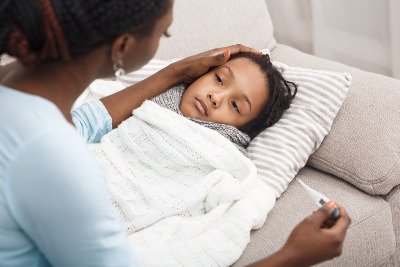Does Your Child Have Allergies, RSV or COVID-19?
 Even before the COVID-19 pandemic, rates of illnesses such as colds and the flu tended to spike when children headed back to school each year. As children get back together, it’s very easy for them to start transmitting all kinds of infections and viruses to each other that they hadn’t been sharing over the summer.
Even before the COVID-19 pandemic, rates of illnesses such as colds and the flu tended to spike when children headed back to school each year. As children get back together, it’s very easy for them to start transmitting all kinds of infections and viruses to each other that they hadn’t been sharing over the summer.
This year, healthcare providers have already seen an increase in respiratory syncytial virus, or RSV. This common childhood illness generally causes mild cold-like symptoms but can be serious, especially for infants. While RSV typically occurs in colder months, current cases of the illness have been severe enough to require many children to be hospitalized.
This spike in RSV cases coincides with a surge in cases of COVID-19 in children with the delta variant, resulting in more children being hospitalized than with previous versions of the virus.
On top of all that, September is the start of ragweed season, and ragweed pollen allergy is a major cause of seasonal allergies. You probably know the condition as “hay fever.”
Fall allergies can cause symptoms that are very similar to symptoms of RSV:
- Sneezing
- Wheezing
- Coughing
- Runny nose or nasal congestion
- Itchy, watery eyes
Of course, several of those symptoms are also indicative of a possible COVID-19 infection. As schools need to be very strict about quarantine requirements if a child shows symptoms of an illness, it’s important to know the difference between allergies and an infection such as RSV or COVID. Otherwise, your child may be out of school for two weeks in quarantine due to run of the mill allergies.
Here are four ways to tell the difference between allergies, RSV and other infections such as a cold, the flu or COVID-19:
1. Allergies won’t cause a fever.
The symptoms of RSV, fall allergies and COVID-19 can look very similar with one major exception—a fever. Each of these ailments can cause significant runny nose, congestion, eye irritation and even some cough. But allergies should not cause any type of temperature spike. If parents detect a fever of 100 degrees or higher, that is an indication of infection as opposed to allergies.
2. A hallmark of allergies is itchiness.
Allergies typically cause very itchy eyes, itchy nose, maybe even itchy skin. While an infection may be irritating, itching is going to most likely be a secondary concern that your child may have.
In other words, with allergies, one of the most common symptoms is itchiness, while in infections such as RSV, itchiness in the eyes and nose can occur but other symptoms such as congestion and cough are most noticeable.
3. Symptoms of allergies last longer than symptoms of RSV.
Usually RSV and other viral infections clear up after one to two weeks. If it’s allergies, your child could have a couple of months’ worth of symptoms. Fall allergy season usually starts in September and can last until the first hard frost, which often may be late into December.
4. Allergy medicine won’t help with symptoms of RSV or other viral infections.
If you think your child has allergies and give him or her allergy medicine and it has little effect on his or her symptoms within 12 to 24 hours, your child might have a viral infection.
An antihistamine that you can get over the counter generally works well for allergies but likely would have very little effect on infection.
If your child has cold-like symptoms and you’re not sure what it is, your child’s doctor can help you figure it out. Don’t send your child to school or other social settings until you’re sure it’s “just” allergies.
If your child isn’t feeling well, talk to your pediatrician or find one near you.